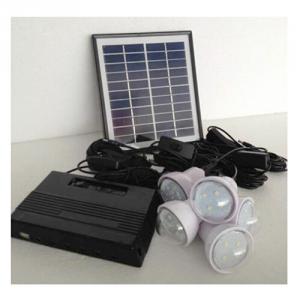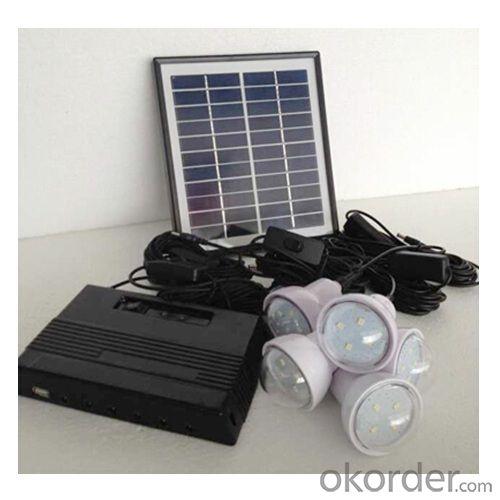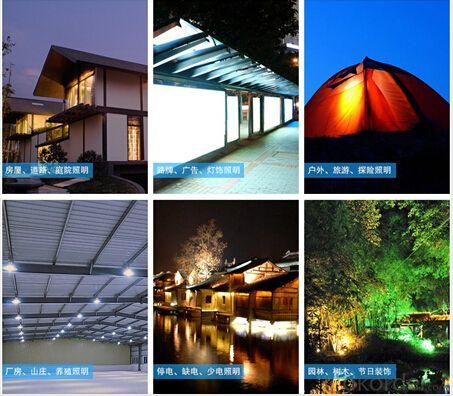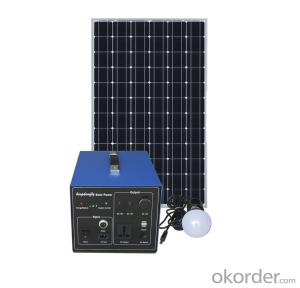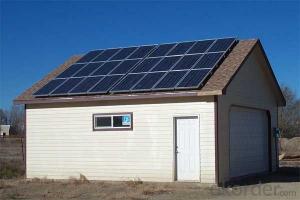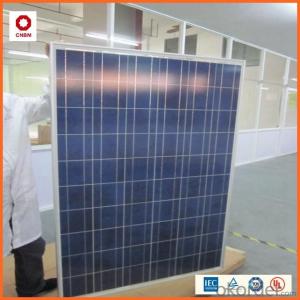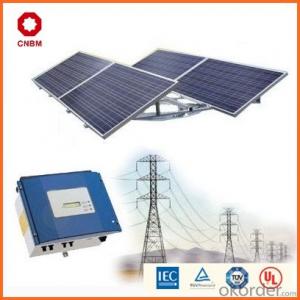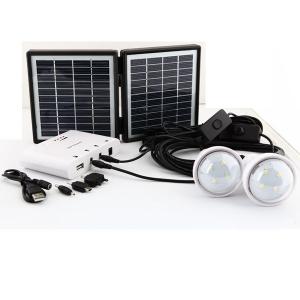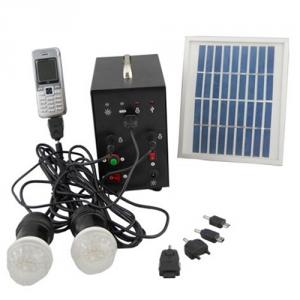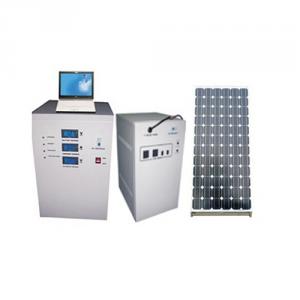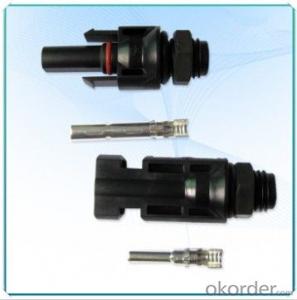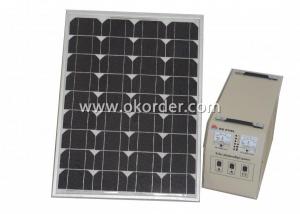Wind Solar Energy Systems - 4W Solar Lighting System with Mobile Charge, 4W Solar Panel, 5200mAh Lithium Battery, Black CE ROHS
- Loading Port:
- Shenzhen
- Payment Terms:
- TT/LC
- Min Order Qty:
- 100Sets set
- Supply Capability:
- 20000 SETS Per Month set/month
OKorder Service Pledge
OKorder Financial Service
You Might Also Like
This 4w solar lighting system with mobile charge 4w solar panel 5200mah lithium batetry black with CE ROHS is a portable solar energy system , with 5200mah li-ion battery . This solar energy generator can generate power for 5 LED bulbs, it can work 6 to 30 hours every day.
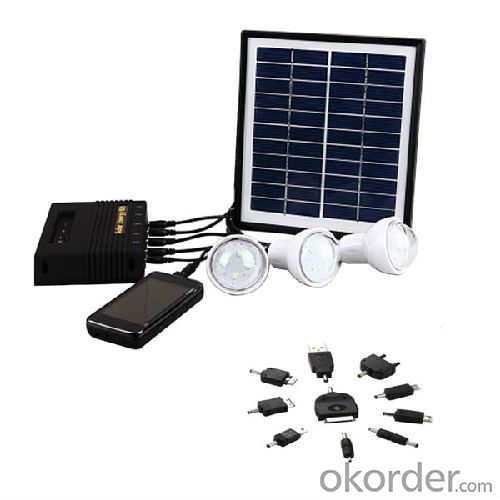
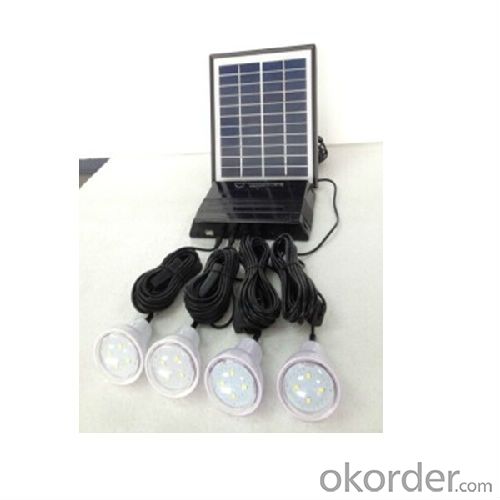
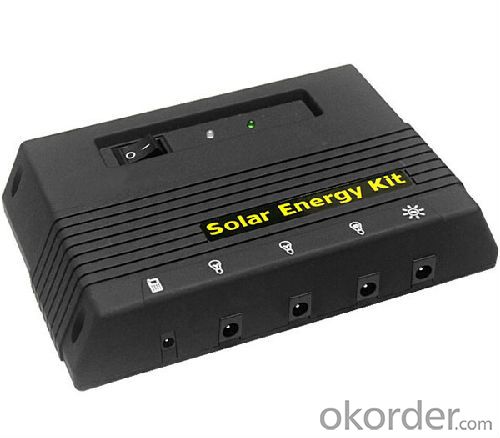
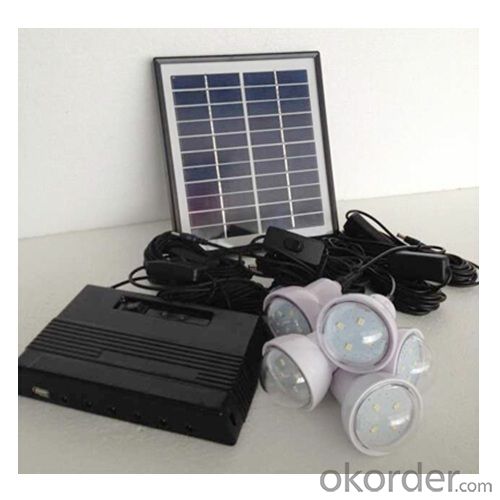
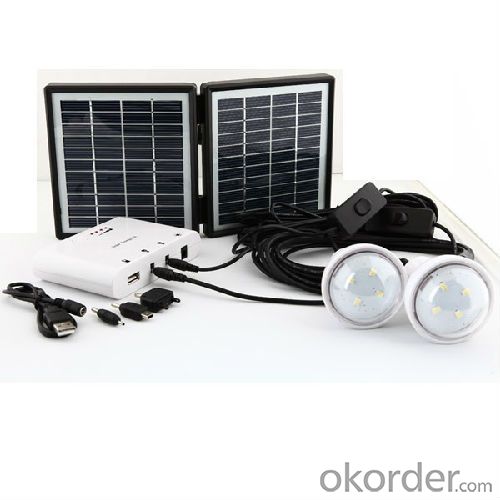
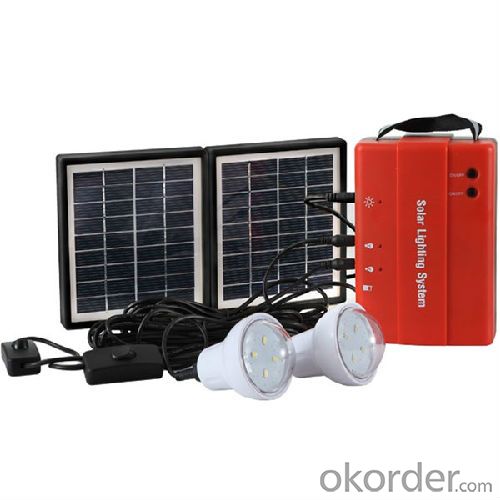
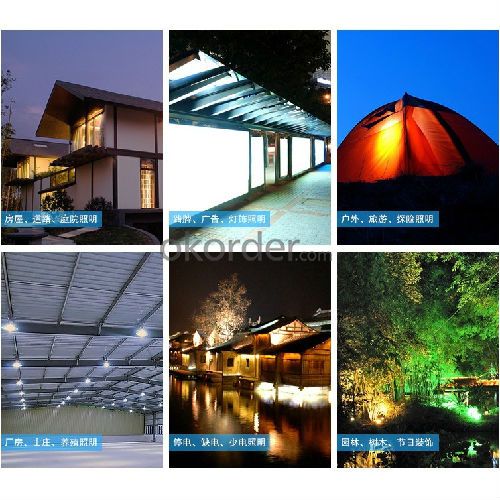
Feature
| Solar Panel: 4W 11V |
| Battery: 5200mAh 7.4V lithium |
| Light Source: 0.9W LED bulb*5 pcs |
| 7.4V 5200mAh Lithium battery |
| 4W 11V Solar Panel with 5M cable |
| 0.9W LED bulb with 5pcs |
| LED bulb: each with 5M cable and switch on cable, IP54. |
| LED charging indicator: yes |
| Mobile phone charging: USB port 5V 1000mA output, with 5-in-1 USB mobile charging cable (Nokia 6101,Sumsung G600, Micro USB, Mini USB,Iphone 4/4S) |
| Overcharge and overdischarge protection: yes |
| Rechargeable by AC charger: optional |
| Working hours on full battery |
| 5 bulbs-6 hours |
| 4 bulbs-7.5 hours |
| 3 bulbs-10 hours |
| 2 bulbs-15 hours |
| 1 bulb-30 hours |
| Full charging time |
| By solar-16 hours (under direct sunshine) |
| By AC charger-about 11 hours |
Usage/Applications
Rural homes, campers, fishermen, outdoor campaigns or activities, etc. Remote area, mountainous area, desert area, grassland area,
Village, country area, Camping, outdoor activities, travel, Lighting at night.
Customized options
1. OEM/ODM available;
2. It's also available to customize your own solar lighting systems, solar lanterns, or any solar lighitng products by giving us solar lights picture / 3D draft / technical datas.
Packing & Delivery
Package:
1* solar panel
1* portable system box
5* LED bulbs with on/off button on cable
inner box size: 335*255*84mm
10pcs/carton
carton size: 525*350*450mm
Delivery:
|
Shipping Service |
Estimated Delivery Time |
|
DHL |
2-8 business days |
|
FedEx |
3-8 business days |
|
TNT |
2-10 business days |
|
UPS |
1-7 business days |
|
EMS |
6-14 business days |
|
ePacket |
7-12 business days |
|
China Post Air Mail |
7-15 business days |
|
China Post SAL |
14-30 business days |
|
Air freight |
3-10 business days |
|
By Sea |
30-40 business days |
1. 3-5 business days for Sample Orders; 7-30 business days for Bulk Orders for Bulk Orders.
2. "Business days" means Monday-Friday, excluding holidays.
3. DHL and UPS cannot ship to military or P.O. boxes address
4. The Shipping Service above is for reference only, for any other questions, please feel free to contact us.
Factory
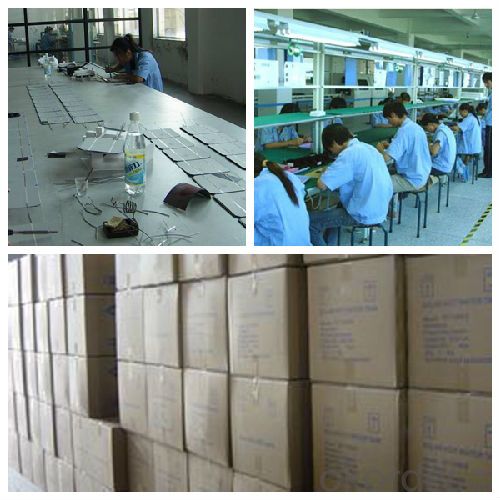
- Q: Can solar energy systems be used in mining operations?
- Yes, solar energy systems can be used in mining operations. Solar power can be harnessed to generate electricity for various mining activities, such as powering equipment, lighting, and ventilation systems. It offers a sustainable and cost-effective alternative to traditional fossil fuel-based energy sources, reducing both operational costs and environmental impact. Additionally, solar energy systems can be easily deployed in remote mining sites where grid electricity may be unavailable or expensive to access.
- Q: Can solar energy systems be used in powering street cameras or surveillance systems?
- Yes, solar energy systems can be used to power street cameras or surveillance systems. Solar energy is a sustainable and renewable source of power that can provide a reliable and independent energy supply for street cameras and surveillance systems. By installing solar panels on rooftops or mounting them on poles near the cameras, the panels can capture sunlight and convert it into electricity. This generated electricity can then be stored in batteries, which can be used to power the cameras and surveillance systems even during periods of low sunlight or at night. Using solar energy for street cameras and surveillance systems not only reduces the reliance on traditional power sources but also helps in reducing carbon emissions and minimizing the overall environmental impact. Additionally, solar-powered systems can be cost-effective in the long run as they eliminate the need for expensive cabling and provide a self-sustaining energy solution. Overall, solar energy systems are an excellent choice for powering street cameras and surveillance systems, offering numerous benefits such as sustainability, reliability, cost-efficiency, and environmental friendliness.
- Q: Can solar panels be used to power agricultural irrigation systems?
- Yes, solar panels can be used to power agricultural irrigation systems. Solar energy can be converted into electricity, which can then be used to power pumps and other irrigation equipment. This sustainable and renewable energy source offers a cost-effective and environmentally friendly solution for powering irrigation systems in remote and off-grid areas.
- Q: Can solar energy systems be used in powering telecommunications towers?
- Yes, solar energy systems can be used to power telecommunications towers. Solar panels can be installed on the towers or nearby to capture sunlight and convert it into electricity. This clean and renewable energy source can provide a reliable power supply for telecommunications equipment, especially in remote or off-grid locations where access to traditional power sources may be limited or costly. Additionally, solar energy systems can help reduce operating costs and dependency on fossil fuels, making them an environmentally friendly choice for powering telecommunications towers.
- Q: What is the role of a solar energy system installer?
- The role of a solar energy system installer is to design, install, and maintain solar energy systems for residential, commercial, and industrial buildings. They play a crucial role in the transition towards renewable energy sources and are responsible for ensuring that solar panels are properly installed and functioning efficiently. Firstly, a solar energy system installer evaluates the site where the solar panels will be installed. They assess factors such as the location, orientation, and shading of the site to determine the optimal design and placement of the panels. This involves conducting a thorough analysis of the site's solar potential and considering any potential obstacles that may affect the system's performance. Once the design is finalized, the installer procures the necessary equipment and materials required for the installation. This includes solar panels, inverters, mounting systems, and electrical components. They also ensure compliance with local building codes and regulations. The installation process involves mounting the solar panels on rooftops or on the ground, connecting them to the electrical system of the building, and wiring them to the inverters. Installers must have a strong understanding of electrical systems to ensure safe and efficient connection of the solar panels. After the installation, solar energy system installers conduct thorough testing and commissioning to ensure that the system is functioning properly. This includes checking the electrical connections, monitoring system performance, and troubleshooting any issues that may arise. In addition to installation, solar energy system installers are also responsible for providing maintenance and repair services. They perform regular inspections, clean the panels, and replace any damaged or faulty components to ensure optimal performance and longevity of the system. They may also assist with system upgrades or expansions as needed. Overall, the role of a solar energy system installer is crucial in promoting the adoption of renewable energy. They are responsible for the successful installation and maintenance of solar energy systems, enabling individuals and businesses to reduce their reliance on fossil fuels and contribute to a more sustainable future.
- Q: Can solar energy systems be used in areas with limited access to solar energy maintenance services?
- Yes, solar energy systems can still be used in areas with limited access to solar energy maintenance services. While regular maintenance and servicing are important for optimal performance and longevity of solar energy systems, advancements in technology have made them more durable and self-sufficient. Additionally, training programs and remote monitoring services are available to help individuals in such areas troubleshoot and maintain their systems effectively. With proper education and support, communities with limited access to maintenance services can still benefit from solar energy.
- Q: Can solar energy systems be used in areas with limited access to the electrical grid?
- Yes, solar energy systems can definitely be used in areas with limited access to the electrical grid. In fact, solar power is an ideal solution for such areas as it offers a decentralized and sustainable source of electricity. Solar energy systems, such as photovoltaic panels, harness the energy from the sun and convert it into usable electricity. These systems can be installed in remote locations without the need for extensive electrical infrastructure. By utilizing solar energy systems, areas with limited access to the electrical grid can become self-sufficient in meeting their energy needs. These systems can power essential appliances, such as lighting, communication devices, and small-scale machinery, providing reliable energy even in areas where traditional grid connections are not available or unreliable. Moreover, solar energy systems can bring numerous benefits to areas with limited grid access. They offer an environmentally friendly alternative to traditional fossil fuel-dependent energy sources, thereby reducing carbon emissions and combating climate change. Solar power systems also provide a reliable and consistent source of energy, reducing the dependence on diesel generators or other costly and polluting forms of energy. Additionally, solar energy can promote economic growth and development in remote areas. By powering essential infrastructure like schools, hospitals, and businesses, solar systems can improve education, healthcare, and economic opportunities. Moreover, the installation and maintenance of solar energy systems can create local jobs and foster entrepreneurship. To ensure the successful implementation of solar energy systems in areas with limited grid access, it is crucial to address challenges such as initial costs, technical expertise, and maintenance. However, with advancements in technology and decreasing costs, solar power has become increasingly accessible and affordable. Various organizations, governments, and non-profit entities are actively working to promote solar energy adoption in such areas and provide necessary assistance. In conclusion, solar energy systems are a viable and sustainable solution for areas with limited access to the electrical grid. They offer a decentralized, reliable, and environmentally friendly source of electricity, bringing numerous benefits to these regions. By harnessing the power of the sun, these systems can empower communities, promote economic development, and improve the quality of life for those living in remote areas.
- Q: How does the angle of the sun affect the performance of a solar energy system?
- The angle of the sun plays a crucial role in determining the performance of a solar energy system. Solar panels work by converting sunlight into electricity through the photovoltaic effect. The angle at which the sun's rays hit the solar panels directly impacts the amount of energy they can generate. When the sun is directly overhead, its rays are perpendicular to the surface of the solar panels, maximizing the energy output. This is known as the solar noon or the peak sun hours. As the sun's angle decreases, such as during morning or evening hours, the sunlight has to travel through a larger portion of the Earth's atmosphere, which reduces its intensity. This results in a decrease in energy production. Moreover, the angle of the sun also changes with the seasons. During the summer months, the sun is higher in the sky, allowing for more direct sunlight and increased energy production. In contrast, during winter, the sun is lower, leading to reduced solar energy output. To optimize the performance of a solar energy system, it is crucial to consider the angle at which the solar panels are installed. The tilt angle of the panels can be adjusted based on the latitude of the location to maximize the exposure to sunlight throughout the year. Additionally, tracking systems can be employed to follow the movement of the sun and adjust the angle accordingly, further enhancing energy production. In conclusion, the angle of the sun directly affects the performance of a solar energy system as it determines the intensity of sunlight reaching the solar panels. By ensuring the optimal angle and orientation of the panels, solar energy systems can generate maximum energy output and improve overall efficiency.
- Q: Are solar energy systems reliable?
- Yes, solar energy systems are reliable. They have proven to be a dependable and consistent source of renewable energy, with advancements in technology making them more efficient and durable.
- Q: Can solar energy systems be used for powering off-grid emergency response centers?
- Yes, solar energy systems can be used to power off-grid emergency response centers. Solar panels can generate electricity by converting sunlight into usable energy, making them a reliable and sustainable power source for remote or off-grid locations. They can provide a continuous supply of electricity, even during emergencies or natural disasters, ensuring that critical equipment and communication systems in emergency response centers remain operational. Additionally, solar energy systems can be combined with energy storage solutions, such as batteries, to store excess electricity generated during the day for use during nighttime or cloudy periods. This makes solar energy an ideal solution for powering off-grid emergency response centers, as they offer independence from traditional power grids and reduce reliance on fossil fuels.
1. Manufacturer Overview
| Location | |
| Year Established | |
| Annual Output Value | |
| Main Markets | |
| Company Certifications |
2. Manufacturer Certificates
| a) Certification Name | |
| Range | |
| Reference | |
| Validity Period |
3. Manufacturer Capability
| a) Trade Capacity | |
| Nearest Port | |
| Export Percentage | |
| No.of Employees in Trade Department | |
| Language Spoken: | |
| b) Factory Information | |
| Factory Size: | |
| No. of Production Lines | |
| Contract Manufacturing | |
| Product Price Range | |
Send your message to us
Wind Solar Energy Systems - 4W Solar Lighting System with Mobile Charge, 4W Solar Panel, 5200mAh Lithium Battery, Black CE ROHS
- Loading Port:
- Shenzhen
- Payment Terms:
- TT/LC
- Min Order Qty:
- 100Sets set
- Supply Capability:
- 20000 SETS Per Month set/month
OKorder Service Pledge
OKorder Financial Service
Similar products
Hot products
Hot Searches
Related keywords
